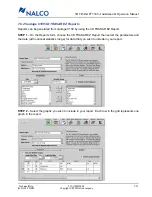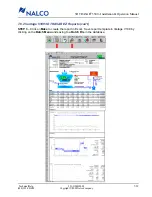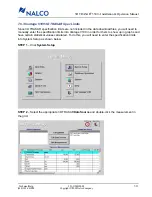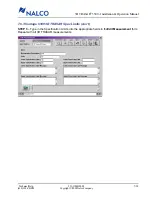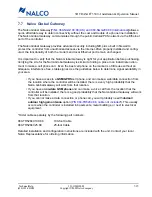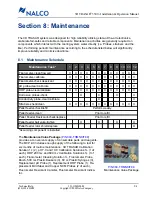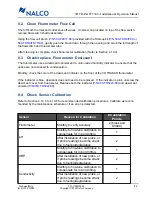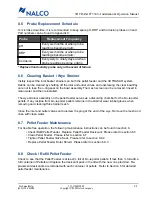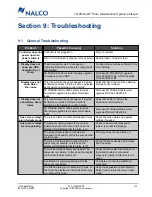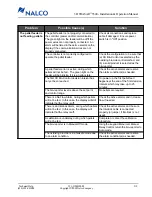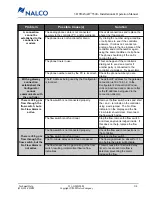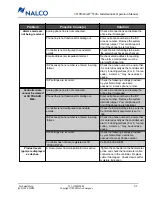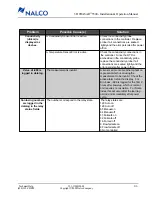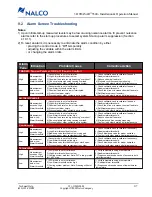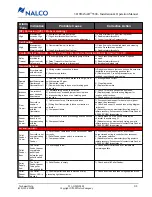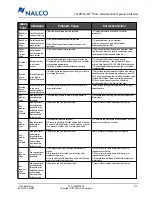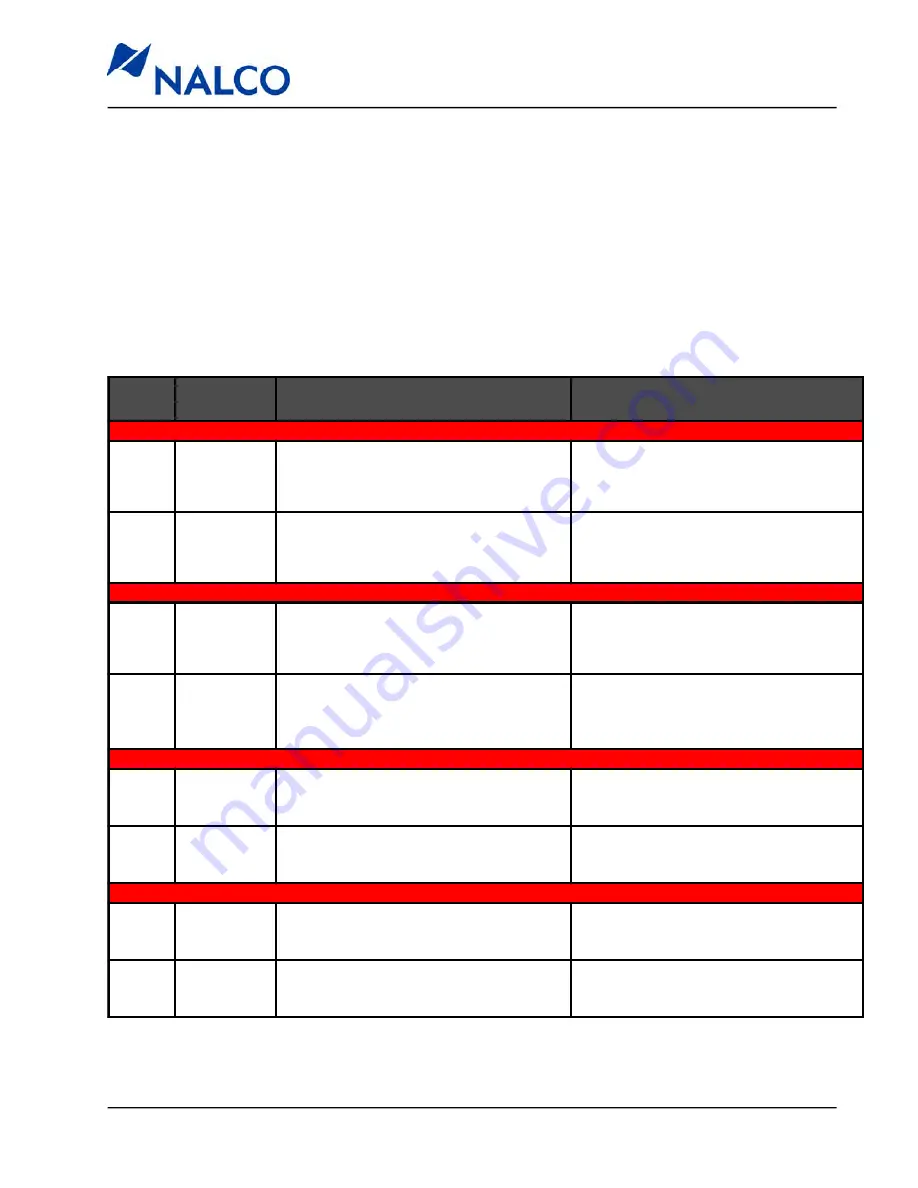
3D TRASAR
5500 - Installation & Operation Manual
521-OM0108.88
Copyright
2009 Nalco Company
9-7
Technical Help
(630) 305-CHEM
Alarm
Type
Indication
Probable Cause
Corrective Action
TRASAR, Tagged Polymer, ORP, pH (Caustic Control)
High
Measurement
exceeds High
Alarm threshold
1) Sensor probe is out of calibration.
2) High Alarm threshold set too low.
3) Chemical feed rate too high causing "overshoot".
4) Chemical pump siphoning causing overfeed.
5) Process leak or other contaminant in system.
1) Check calibration and recalibrate if needed.
2) Readjust alarm threshold.
3) Reduce chemical feed rate.
4) Elminate condition causing siphoning.
5) Confirm (with other data) and eliminate source.
Low
Measurement
below Low
Alarm threshold
1) Sensor probe is out of calibration.
2) Low Alarm threshold set too high.
3) Chemical feed rate too low or interrupted.
4) Product container empty.
5) Process leak or other contaminant in system.
1) Check calibration and recalibrate if needed.
2) Readjust alarm threshold.
3) Check feed line or increase chemical feed rate.
4) Refill/replace product inventory.
5) Confirm (with other data) and eliminate source.
pH (Acid Control)
High
Measurement
exceeds High
Alarm threshold
1) Sensor probe is out of calibration.
2) High Alarm threshold set too low.
3) Chemical feed rate too low or interrupted.
4) Product container empty.
5) Process leak or other contaminant in system.
1) Check calibration and recalibrate if needed.
2) Readjust alarm threshold.
3) Check feed line or increase chemical feed rate.
4) Refill/replace product inventory.
5) Confirm (with other data) and eliminate source.
Low
Measurement
below Low
Alarm threshold
1) Sensor probe is out of calibration.
2) Low Alarm threshold set too high.
3) Chemical feed rate too high causing "overshoot".
4) Chemical pump siphoning causing overfeed.
5) Process leak or other contaminant in system.
1) Check calibration and recalibrate if needed.
2) Readjust alarm threshold.
3) Reduce chemical feed rate.
4) Eliminate condition causing siphoning.
5) Confirm (with other data) and eliminate source.
Conductivity
High
Measurement
exceeds High
Alarm threshold
1) Sensor probe is out of calibration.
2) High Alarm threshold set too low.
3) Blowdown valve throttled too low or plugged.
4) Process leak or other contaminant in sy stem.
1) Check calibration and recalibrate if necessary.
2) Readjust alarm threshold.
3) Check blowdown valve for proper operation.
4) Confirm (with other data) and eliminate source.
Low
Measurement
below Low
Alarm threshold
1) Sensor probe is out of calibration.
2) Low Alarm threshold set too high.
3) Blowdown valve throttled too high or stuck open.
4) Process leak or other contaminant in sy stem.
1) Check calibration and recalibrate if necessary.
2) Readjust alarm threshold.
3) Check blowdown valve for proper operation.
4) Confirm (with other data) and eliminate source.
Temperature
High
Measurement
exceeds High
Alarm threshold
1) RTD probe is out of calibration
2) High Alarm threshold set too low.
3) Cooling system problem. Note: PVC piping is rated
for 140 F max.
1) Verify temperature using a thermometer.
2) Readjust alarm threshold.
3) Diagnose and resolve cause of excessive bulk
water temperature.
Low
Measurement
below Low
Alarm threshold
1) RTD probe is out of calibration.
2) Low Alarm threshold set too high.
3) Cooling system problem. Note: Freezing will burst
piping.
1) Verify temperature using a thermometer.
2 ) Readjust alarm threshold.
3) Diagnose and resolve cause of low bulk water
temperature.
9.2
Alarm Screen Troubleshooting
Notes
:
1) Upon initial start-up measured levels may be low causing nuisance alarms. To prevent nuisance
alarms refer to the start-up procedures to select system Start-up alarm suppression (Section
4.10.11).
2) To reset an alarm it is necessary to eliminate the alarm condition by either.
• placing the control mode in “Off” temporarily
• adjusting the variable within the alarm limits
• or changing the alarm limits.

